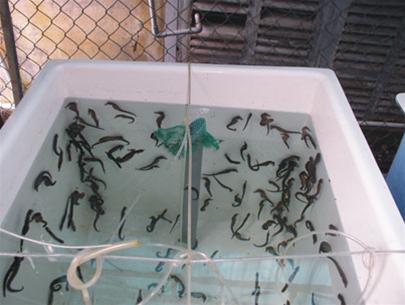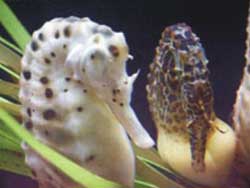Passionate about the fish known for its “enhancing vitality and kidney health,” scientists at the Nha Trang Oceanography Institute (Khánh Hòa) have pooled resources and developed equipment to research the breeding process and commercial farming of seahorses. Their hard work has paid off.
The three species of seahorses that the institute has successfully bred are the black seahorse (Hippocampus kuda), the zebra seahorse (H. comes), and the spiny seahorse (H. spinosissimus).

Seahorses bred at the Nha Trang Oceanography Institute
(Photo: Can Lộc)
With this success, the institute expects to breed between 5,000 to 7,000 seahorses each month in a small-scale production facility, with a tank capacity of approximately 20m³ of seawater.
According to Dr. Trương Sĩ Kỳ, the value of the technology for breeding and farming seahorses is around 2 billion VND. The investment for seahorse farming is relatively low, but the profit margins are quite high, with a survival rate exceeding 70%.
 |
|
Seahorse (Photo: TTO) |
Despite being artificially bred, the quality of the seahorse offspring ensures good growth, normal development, and a higher reproduction rate compared to wild seahorses. Seahorses raised for six months will reach sexual maturity and reproduce for the F2 generation, completing the seahorse life cycle.
Dr. Kỳ further stated that in the near future, people may be able to farm seahorses in shrimp hatcheries. Notably, the Nha Trang Oceanography Institute has also successfully changed the color of seahorses for ornamental purposes.
“Typically, seahorses are black, but we can change them to yellow, and sometimes even red,” Dr. Kỳ said.
According to the institute’s scientists, if well-invested and with a market for live seahorses for medical use in China and Hong Kong, as well as for ornamental purposes in Western countries, the economic benefits would far exceed those of other farming models.
CAN LỘC















































